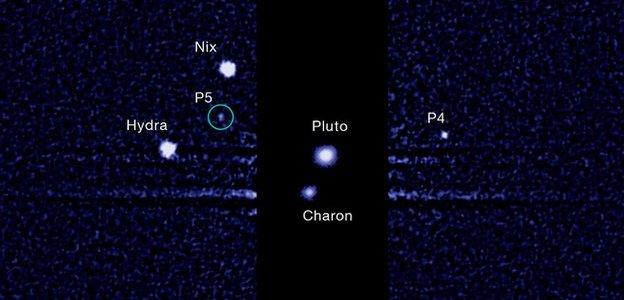Hubble discovers new Pluto moon
- Published

The newfound moon (P5) is visible as a speck of light
The Hubble Space Telescope has discovered a fifth moon circling the dwarf planet Pluto.
The new moon, visible as a speck of light in Hubble images, is estimated to be irregular in shape and between 10km and 25km across.
Scientists are intrigued that such a small world can have such a complex collection of satellites.
The moon - known only as P5 - could help shed light on how the Pluto system formed and evolved.
According to one idea, all the moons are relics of a collision between Pluto and another large icy object billions of years ago.
"The moons form a series of neatly nested orbits, a bit like Russian dolls," said Mark Showalter from the Seti Institute in Mountain View, US, the leader of the team that discovered the new moon.
Pluto's largest moon, Charon, was discovered in 1978. Hubble observations in 2006 uncovered two additional small moons, Nix and Hydra.
In 2011, another moon, known as P4, was found by Hubble.
Provisionally named S/2012 (134340) 1, or P5, the latest moon was detected in nine separate sets of images taken by Hubble's Wide Field Camera 3 taken during June and July.
New Horizons, an unmanned Nasa spacecraft, is currently en route to Pluto, with a flyby of the object scheduled for 2015.
It will return the first ever detailed images of the Pluto system, which is so small and distant that even Hubble can barely see the largest features on its surface.
Discovered in 1930 by the American Clyde Tombaugh, Pluto was regarded as the ninth planet in the Solar System until its demotion in 2006.
The decision to recategorize Pluto as a "dwarf planet" was driven by a recognition that it is one of several large, icy objects that reside in the Kuiper Belt, a region just beyond the orbit of Neptune.
- Published21 July 2011